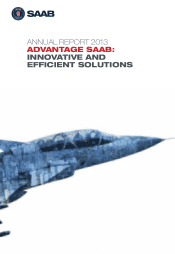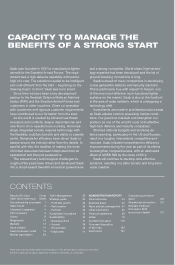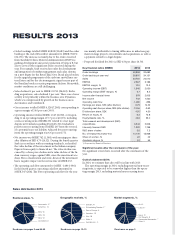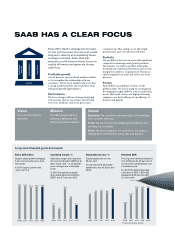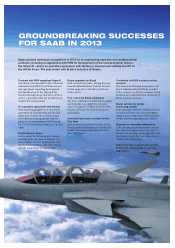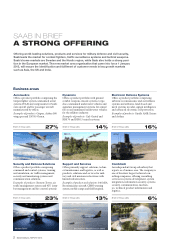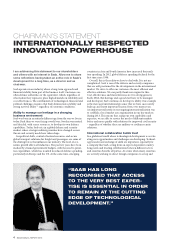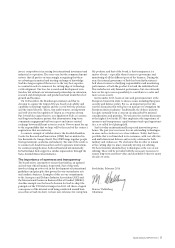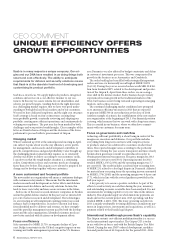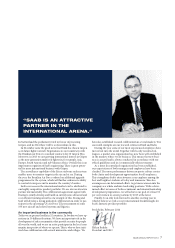Saab 2013 Annual Report Download - page 9
Download and view the complete annual report
Please find page 9 of the 2013 Saab annual report below. You can navigate through the pages in the report by either clicking on the pages listed below, or by using the keyword search tool below to find specific information within the annual report.
SAAB ANNUAL REPORT 2013 5
invest, competition is increasing for international investment and
industrial co-operation. e areas vary, but the common denomi-
nator is that all parties are increasingly recognising that there
are advantages in mutual and trusting exchange of knowledge.
Saab has long recognised that access to the very best expertise
is essential in order to remain at the cutting edge of technologi-
cal development. Our base for research and development is in
Sweden, but without our international partnerships in education,
research and development, and production Saab would have lost
ground and business.
On 18 December, the Brazilian government said that its
decision to acquire the Gripen NG was based on its ability and
capability, technology transfer and the cost of both the purchase
and the entire lifecycle. is is, rst and foremost, an important
and well-deserved recognition of Gripen as a weapons system.
But I would also argue that it is a recognition of Saab as a serious
and long-term business partner that demonstrates long-term
community engagement built on respect and sincere mutual
exchange between dierent actors in society. Now we must live up
to the responsibility that we hope will be the result of the contract
negotiations that are underway.
A concrete example of collaboration is the Swedish-Brazilian
Centre for Research and Innovation (CISB) that we initiated in
São Bernardo do Campo, Brazil. e CISB brings together people
from government, academia and industry. e aim of the centre is
to conduct self-funded research in order to generate innovations
for commercial application, both in Brazil and internationally.
In Switzerland, Saab supports a similar organisation through the
Swiss-Swedish Innovation Initiative.
The importance of openness and transparency
e board strives constantly to ensure that Saab has an updated
and relevant ethical business framework. Part of this work
involves taking an active role in the development of international
guidelines and principles that govern the way our industry acts
and conducts business. Examples of this are our commitments
to the Aerospace and Defence Industry Association (ASD) and
the International Forum on Business Ethical Conduct (IFBEC).
Another example was the board’s decision for Saab to adopt the
principles of the UN Global Compact in 2011. All this is a logical
consequence of the internal work being conducted around busi-
ness ethics at Saab. In short, we have zero tolerance for corruption.
My position, and that of the board, is that transparency is a
matter of trust – especially when it comes to governance and
monitoring of all the dierent parts of the business. During the
year, the internal governance of Saab has been further intensi-
ed when it comes to clarifying responsibilities and monitoring
performance, at both the product level and the individual level.
is includes not only nancial performance, but also obviously
how we live up to our responsibility to contribute to a safer and
more secure society.
In December 2013, heads of state and government met at the
European Council in order to discuss issues including European
security and defence policy. For us, an important part of this
was the discussion that took place on measures to strengthen the
European defence industry. Traditionally, the defence industry
has quite naturally been a concern circumscribed by national
considerations and priorities. We welcome the current discussion
at the highest level in the EU that emphasises the importance of
openness and transparency, equal treatment and equal opportuni-
ties, a so-called level playing eld.
Saab is today an internationally respected innovation power-
house. e past year’s successes for our outstanding technologies
in areas such as radar serve as clear evidence. Today, Saab has a
portfolio that is well matched to its customers, with cost-eective
and multi-functional defence and security solutions for both
military and civilian use. We also know that in order to remain
at the cutting edge we must constantly develop our oering.
We have therefore identied key technologies at the core of our
oering. ese will be provided with the necessary resources to
ensure long-term customer value and shareholder value for many
decades to come.
Stockholm, February 2014
Marcus Wallenberg
Chairman

